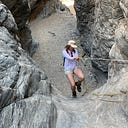Member-only story
You know how some words can be so confusing? Well, gneiss is one of them. Gneiss is a type of rock, but not just any rock, it’s a ZEBRA rock. Trippy I know, an animal rock. By the way, it is pronounced like the English word “nice”, no not “niece” as in the opposite of nephew, but “nice” as in, “Nice car dude.” The word Gneiss derives from a German origin and directly means bright or spark alluding to the sparkly appearance from the crystal grains within the rock called schistocity. Below are a couple examples of gneiss rocks showing the most illustrative characteristics of banding, or stripes.
Gneiss, where do you get your stripes?
When certain types of rocks like sedimentary or igneous rocks are exposed to high pressure and high heat within the Earth’s crust, they change into different types of rocks, like a gneiss. A sedimentary rock is typically formed by small grains of mud, sand, or small rocks that become cemented together into a different form such as sandstone and mudstone. Many times, the parent rock, or the kind of rock prior to metamorphism (process of changing under heat and pressure), of a gneiss is a sedimentary rock, the sandstone or mudstone mentioned above. When rocks like sandstone and mudstone, which have various mineral distributions, are subjected to the metamorphic process the mineral grains link together and form bands within the rock that vary in…
